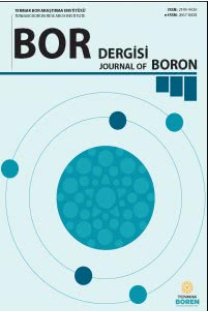Mechanical and thermal properties of boric acid and paper mill sludge reinforced polyester composites
Mechanical and thermal properties of boric acid and paper mill sludge reinforced polyester composites
This study is aimed to produce polymer composite materials with low thermal conductivity coefficient and high mechanical strength. Therefore, different rates of boric acid and paper mill sludge were added to the polyester matrix and the composite materials were characterized in terms of mechanical and thermal properties. Based on the experimental results, the highest bending strength (21.83 MPa) was achieved in the presence of 5% paper mill sludge and 3% boric acid. Compared to the reference, the decomposition temperatures of composites increased with the addition of additives. Also, the densities of composites ranged from 1.141 g/cm3 and 1.409 g/cm3. The additives of paper mill sludge and boric acid decreased the thermal conductivity coefficient of composites and lowest coefficient of thermal conductivity was reported as 0.61 W/mK. Consequently, boric acid and paper mill sludge additions enhance the mechanical and thermal properties of polyester-based composite material.
___
- [1] Zhang S., Cao X. Y., Ma Y. M., Ke Y.C., Zhang J. K., Wang F. S., The effects of particle size and content on the thermal conductivity and mechanical properties of Al2O3/high density polyethylene (HDPE) composites, Express. Polym. Lett., 5 (7), 581-590, 2011.
- [2] Zhou W., Qi S., An Q., Zhao H., Liu N., Thermal con-ductivity of boron nitride reinforced polyethylene com-posites, Mater. Res. Bull., 42 (10), 1863-1873, 2007.
- [3] Li S., Qi S., Liu N., Cao P., Study on thermal conduc-tive BN/novolac resin composites, Thermochim. Acta, 523 (1-2), 111-115, 2011.
- [4] Wang M., Kang Q., Pan N., Thermal conductivity en-hancement of carbon fiber composites, Appl. Therm. Eng., 29 (2-3), 418-421, 2009.
- [5] Naficy S., Garmabi H., Study of the effective parame-ters on mechanical and electrical properties of carbon black filled PP/PA6 microfibrillar composites, Com-pos. Sci. Technol., 67 (15-16), 3233-3241, 2007.
- [6] Tekce H. S., Kumlutas D., Tavman I. H., Effect of particle shape on thermal conductivity of copper rein-forced polymer composites, J. Reinf. Plast. Compos., 26 (1), 113-121, 2007 (in Turkish).
- [7] Cheewawuttipong W., Fuoka D., Tanoue S., Uematsu H., Iemoto Y., Thermal and mechanical properties of polypropylene/boron nitride composites, Energy Pro-cedia, 34, 808-817, 2013.
- [8] Visakh P. M., Nazarenko O. B., Amelkovich Y. A., Mel-nikova T. V., Thermal properties of epoxy composites filled with boric acid, IOP Conf. Ser.: Mater. Sci. Eng., 81, 12095, 2015.
- [9] Scott G. M, Smith A., Sludge characteristics and dis-posal alternatives for the pulp and paper industry. TAPPI Int. Environ. Conf., Atlanta-A.B.D., 269, 1995.
- [10] Dorris G. M., The physical characterization of hydrat-ed reburned lime and lime mud particles, J. Pulp Pap. Sci., 19 (6), 256-267, 1993.
- [11] Bajpai P., Biokraft pulping of eucalyptus with selected lignin-degrading fungi, J. Pulp Pap. Sci., 27 (7), 235-239, 2001.
- [12] Küçükdoğan N., Halis S., Sütçü M., Sarıkanat M., Seki Y., Sever K., Kağıt üretim atığı katkılı yüksek yoğunluklu polietilen (yype) kompozitlerin mekanik özelliklerinin incelenmesi, PAJES, 23 (8), 949-953, 2017.
- [13] Pöllänen M., Suvanto M., Pakkanen T. T., Cellulose reinforced high density polyethylene composites-Mor-phology, mechanical and thermal expansion proper-ties, Compos. Sci. Technol., 76, 21-28, 2013.
- [14] Huang H. B., Du H. H., Wang W. H., Shi J. Y., Charac-teristics of paper mill sludge-wood fiber-high-density polyethylene composites, Polym. Compos., 33 (9), 1628-1634, 2012.
- [15] Son J., Kim H., Lee P., Role of paper sludge particle size and extrusion temperature on performance of pa-per sludge-thermoplastic polymer composites, J. Appl. Polym. Sci., 82 (11), 2709-2718, 2001.
- [16] Akkurt S., Sütçü M., Başoğlu K., Isı yalıtım özellkleri iyileştirilmiş yapı tuğlalarının geliştirilmesinde kağıt üretim atıklarının kullanılması etkileri, X. Ulusal Tesisat Mühendisliği Kongresi, İzmir-Türkiye, 899-908, 13-16 Nisan 2011.
- [17] Li M., Wan Y., Gao Z., Xiong G., Wang X., Wan C., Luo H., Preparation and properties of polyamide 6 thermal conductive composites reinforced with fibers, Mater. Des., 51, 257-261, 2013.
- [18] Rao K. M. M., Rao K. M., Prasad A. V. R., Fabrication and testing of natural fibre composites: Vakka, sisal, bamboo and banana, Mater. Des., 31 (1), 508-513, 2010.
- [19] Ramanaiah K., Prasad A. V. R., Reddy K. H. C., Ther-mal and mechanical properties of waste grass broom fiber-reinforced polyester composites, Mater. Des., 40, 103-108, 2012.
- [20] Demirel M., Pamuk V., Dilsiz N., Investigation of flame retardancy and physical-mechanical properties of zinc borate/boric acid polyester composites, J. Appl. Polym. Sci., 115 (5), 2550-2555, 2010.
- [21] Li J., Cai C. L., The carbon fiber surface treatment and addition of PA6 on tensile properties of ABS compos-ites, Curr. Appl. Phys., 11 (1), 50-54, 2011.
- [22] Pehlivanlı Z. O., H3BO3/PP kompozitlerinin ısı ile-tim katsayılarının incelenmesi, Gazi Üniversitesi Fen Bilim. Derg. Part C Tasarım ve Teknol., 4 (3), 91-96, 2016.
- [23] Yang S. Y., Lin W. N., Huang Y. L., Tien H. W., Wang J. Y., Ma C. C. M., Li S. M., et al., Synergetic effects of graphene platelets and carbon nanotubes on the me-chanical and thermal properties of epoxy composites, Carbon, 49 (3), 793-803, 2011.
- ISSN: 2149-9020
- Yayın Aralığı: Yılda 4 Sayı
- Başlangıç: 2016
- Yayıncı: TENMAK Bor Araştırma Enstitüsü
Sayıdaki Diğer Makaleler
Ali Yaraş, Hacı İbrahim Çeliker, Ahmet Çetin Başbozkurt
Hacı Deveci, Abidin Temel, İlhan Ehsani, Abdullah Obut, Abdulkerim Yörükoğlu, Zeynep Aktosun, İsmail Girgin
Boron doped hydroxyapatites in biomedical applications
Bengi Yılmaz, İdil Uysal, Zafer Evis
Hazal GERGEROGLU, Neslihan SAKAR, Hamed GHORBANPOOR, Çağlar ÖZER
Hamed Ghorbanpoor, Hazal Gergeroğlu, Neslihan Sakar, Çağlar Özer
İdil UYSAL, Bengi YILMAZ, Zafer EVİS
Hacı ÇELİKER, Ahmet BAŞBOZKURT, Ali YARAŞ
Abdullah OBUT, İlhan EHSANİ, Zeynep AKTOSUN, Abdulkerim YÖRÜKOĞLU, İsmail GİRGİN, Abidin TEMEL, Hacı DEVECİ
